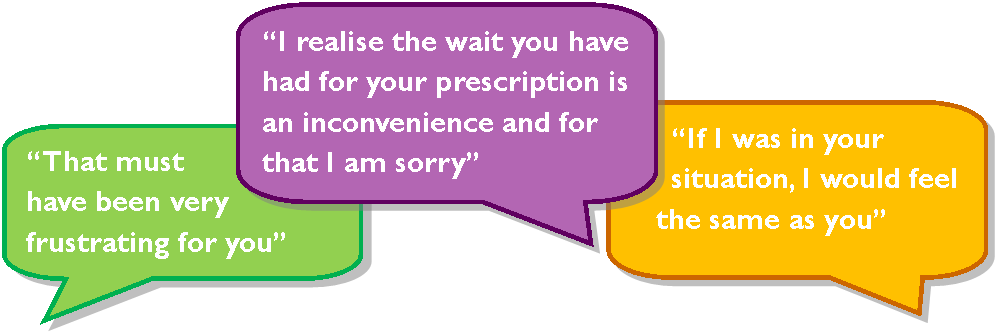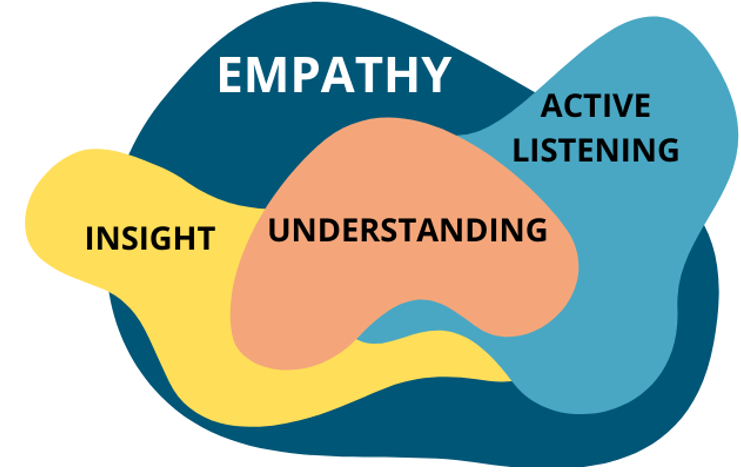Showing empathy
Empathy is the ability to identify with or understand and share the person's feelings. Demonstrating empathy to the customer when they are angry can help to calm them down, as it can show them that you understand how they feel. Empathy should not be confused with sympathy. Sympathy is an expression of how you feel in response to someone else's experience or feelings, empathy is the ability to 'walk in the other person's shoes' and has nothing to do with how you feel; it's about understanding how the other person feels in the circumstances. A customer will not want sympathy; they simply want their emotions understood and recognised.
Phrases to help show empathy:

Another technique to consider is known as 'sidestepping' and this can be particularly useful if the customer is angry and moving away from the actual complaint that they have. It helps to focus the conversation on the issue at hand rather than any side issues by acknowledging what they have said and focusing on finding a solution. For example, a customer is angry that the indigestion remedy they normally purchase is out of stock and they start to raise their voice saying that "Your pharmacy is rubbish, you are always slow serving and you never have enough products stocked". To sidestep and bring the conversation back you could try "I am really sorry we do not have your normal indigestion product in stock, let me see when we will have this in stock again or if there is a suitable alternative we could recommend".
Case study
A customer has come into the pharmacy and become angry because they were expecting to pick up prescription items for their ill relative, only to find that they are not ready. They are shouting about how they have made a special journey during their lunch break and have "never seen such unprofessional service" and that they "were lied to that it would be ready now". It would be easy to react in this kind of situation and immediately try to defend the pharmacy. However, it is important to remain calm and listen carefully to the customer, first recognising why they are angry by showing empathy, before trying to respond or give any explanation. In this example, the pharmacy may have been waiting for a delivery of the medication for the prescription which they can explain once the customer has calmed down and reassure the customer that they will do their utmost to get it ready as soon as possible.
When providing the customer with a reason why something may have happened that has upset them, try not to make excuses on behalf of the pharmacy or go into too much detail. This could antagonise a customer further as this is not really their concern; they simply want a solution to be found and an apology given. Also avoid placing the blame on other employees or suppliers as it then looks like the pharmacy is trying to deflect responsibility. So, for the case study example, all the customer would need to hear is that there has been a delay in the delivery and not because it was due to a vehicle breakdown or an ongoing problem with the supplier.
There may be occasions when the customer does not calm down, it is important to remind yourself that this is not personal and that there may be many other factors that are contributing to this anger which are more than likely out of your control. The anger itself could be directly related to their medical condition or medication they are taking. There is also the possibility they could be under the influence of alcohol or other non-prescription drugs. This is where knowing your regular customers can be highly beneficial to the pharmacy; understanding what can make a customer become volatile can help you predict situations and take action to avoid potential problems.
For example, consider the situation where a regular customer is visiting the pharmacy for their methadone prescription. If there is a delay they could potentially become quite anxious as they start to experience withdrawal symptoms that will be alleviated by the methadone. Recognising and taking proactive action in this situation such as ensuring the medication is ready at the start of the day or providing them with a clear expected time they will have to wait could help alleviate any anxiety.
If an angry customer still fails to calm down, calmly but assertively explain that you can only help them reach the solution they require if they can provide you with further information. If possible, suggest moving to a private area if it feels safe to do so, such as the consultation room away from other customers where the individual can sit down, it is harder to continue shouting when sitting down. It may also help to ask if they would like to speak to another more senior member of the team or the pharmacist. If going to a quiet area it might be good to consider a Chaperone but at the very least ensure the customer is not blocking the exit from the room because if the situation does not diffuse there needs to be a clear escape / exit route if needed.

